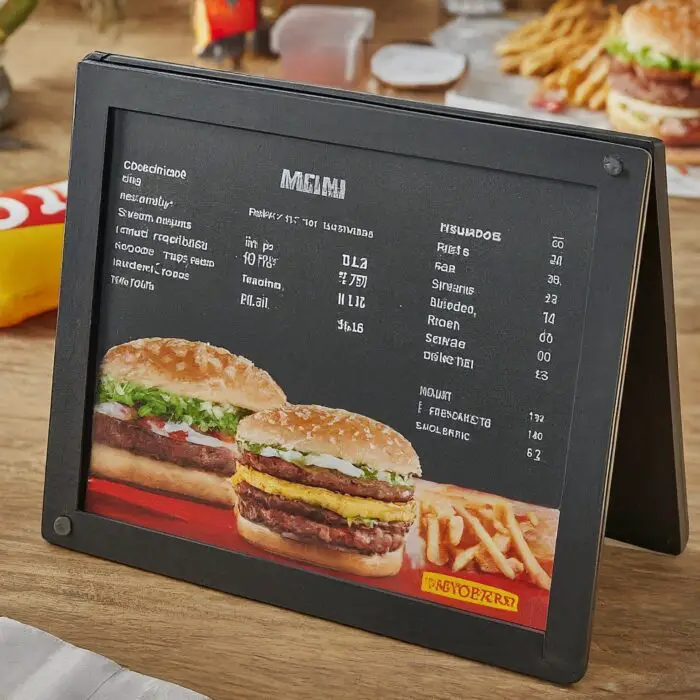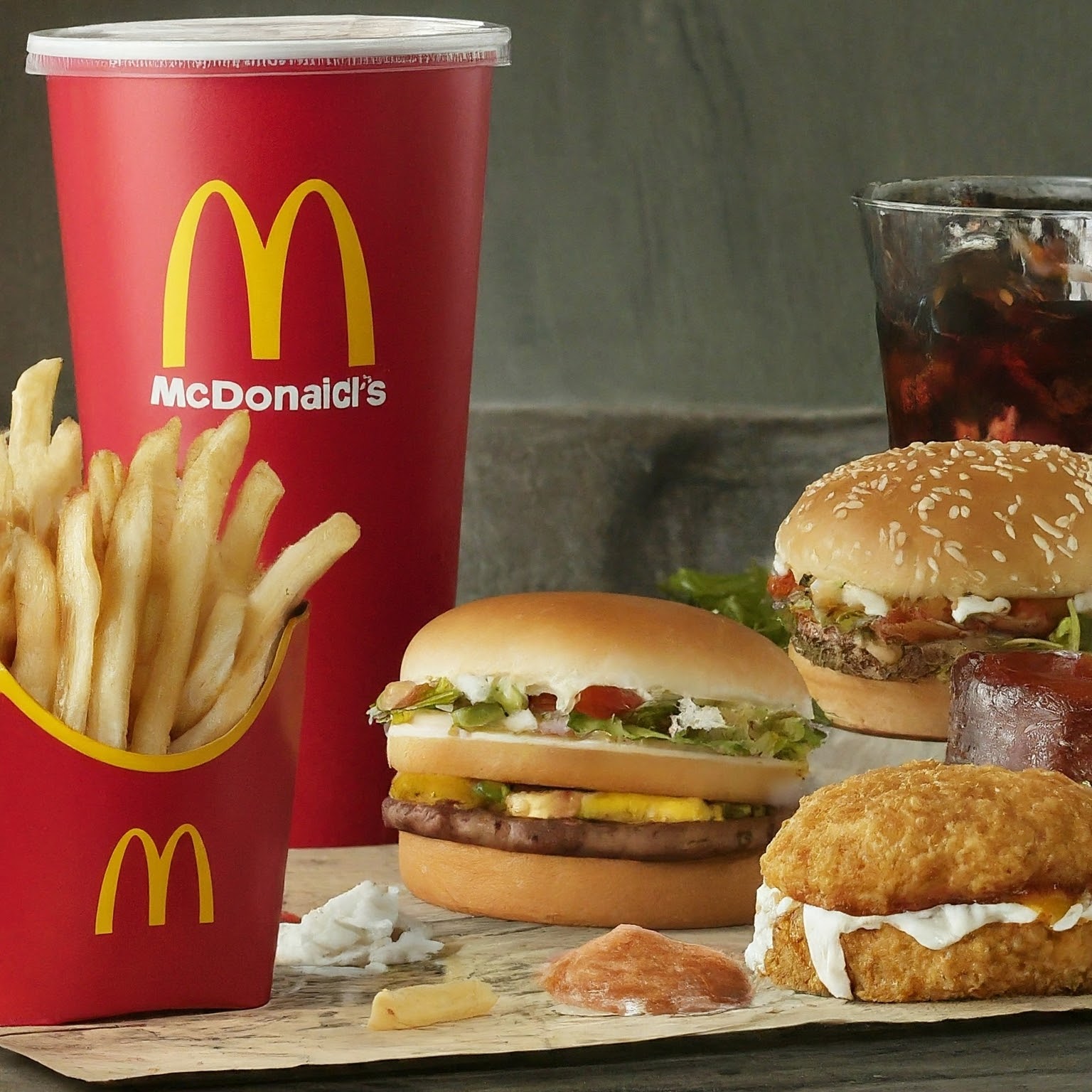
A menu display.
Understanding McDonald’s Nutritional Landscape
Understanding the nutritional offerings at McDonald’s requires a comprehensive dive into their menu.
Renowned globally for its fast-food staples like Big Macs, French fries, and McFlurries, health-conscious individuals often critique the chain for its high-calorie, high-fat, and high-sugar offerings.
However, a modernized menu now includes several healthier choices. The objective is to navigate through these options intelligently, ensuring a balance between taste and nutrition.
Nutritional Content of Popular Items
Analyzing some of McDonald’s most popular items reveals varying nutritional profiles:
– Big Mac: Contains approximately 550 calories, 25 grams of fat (8 grams saturated), 45 grams of carbs, and 25 grams of protein.
– Medium Fries: Offers around 340 calories, 16 grams of fat (2.5 grams saturated), 44 grams of carbs, and 3 grams of protein.
– McFlurry with M&M’s (Snack Size): Roughly 430 calories, 14 grams of fat (9 grams saturated), 68 grams of carbs, and 10 grams of protein.
These items showcase the high-caloric nature of some menu options, which can be concerning if consumed regularly without considering overall dietary intake.
Healthier Choices at McDonald’s
McDonald’s has made strides in offering healthier choices and vegetarian options to cater to a broader audience:
– Artisan Grilled Chicken Sandwich: Featuring 380 calories, 6 grams of fat, 44 grams of carbs, and 37 grams of protein, this sandwich is a lower-calorie alternative to traditional burgers.
– Fruit & Maple Oatmeal: Made with whole grains, providing 320 calories, 4 grams of fat, 64 grams of carbs, and 6 grams of protein.
– Southwest Grilled Chicken Salad: One of the healthier options, delivering 350 calories, 11 grams of fat, 27 grams of carbs, and 37 grams of protein.
Including these items as part of a balanced meal can help those seeking more nutritious alternatives without entirely sacrificing convenience or cost.
Customization for Lower Caloric Intake
Customization can play a vital role in managing caloric and nutritional intake at McDonald’s:
– Skip or Reduce Sauces and Dressings: Standard burgers and sandwiches can have their caloric content significantly reduced by asking for no sauce or less dressing.
– Opt for Grilled Proteins: Instead of fried options (e.g., Chicken McNuggets), choosing grilled proteins (e.g., Artisan Grilled Chicken Sandwich) is a healthier alternative.
– Half-Size Portions: Requesting half portions or choosing items from the Happy Meal menu can control portions and manage caloric intake better.
Engaging in these simple customizations can substantially enhance the nutritional profile of your meal.

Inside view of McDonald’s restaurant.
Understanding McDonald’s Kids’ Menu
The McDonald’s Kids’ Menu, particularly Happy Meals, offers balanced offerings aimed at children’s nutrition:
– 4-piece Chicken McNuggets Happy Meal: Approximately 395 calories, 18 grams of fat, 43 grams of carbs, and 15 grams of protein.
– Hamburger Happy Meal: Roughly 475 calories, 18 grams of fat, 65 grams of carbs, and 17 grams of protein.
These meals often come with a side of apple slices and a choice of drink like milk or juice, facilitating a well-rounded meal. Being mindful of the offered drinks and side options can further optimize nutritional benefits for children.
The Role of Beverage Choices
Drinks can significantly contribute to the overall nutritional intake of a meal:
– Water or Unsweetened Tea: Calorie-free options that keep you hydrated without adding unnecessary sugars and calories.
– Sodas and Sweetened Drinks: A medium Coke has around 210 calories and 58 grams of sugar, showing the potential impact of liquid calories.
– Coffee Choices: McDonald’s offers a range of coffee drinks; opting for black coffee or those with minimal milk and sweeteners can reduce calorie intake compared to frappés or lattes.
These insights highlight the importance of making informed choices regarding beverages to maintain a healthy diet.
McDonald’s Global Adjustments for Health Consciousness
Globally, McDonald’s has adapted its menu to reflect regional health trends and preferences:
– China: Offers congee and soy milk, catering to local dietary habits and perceived health benefits.
– Sweden: Provides organic milk and eco-friendly fish fillets, aligning with national health and sustainability goals.
– India: Features a range of vegetarian options to accommodate dietary restrictions and preferences.
These regional variations underscore McDonald’s responsiveness to global health trends and its commitment to providing diversified options.
Mindful Eating Practices
Integrating mindful eating practices when dining at McDonald’s can improve the overall health impact:
– Balance with Other Meals: If indulging in a high-calorie item, balancing it with lighter meals throughout the day can help maintain an ideal caloric intake.
– Moderation and Frequency: Limiting visits to fast-food establishments and viewing them as occasional treats rather than regular meals.
– Informed Choices: Utilizing McDonald’s nutritional guide, available online and in-store, to make educated decisions about what you consume.
Adopting these practices allows individuals to enjoy McDonald’s offerings without compromising their long-term health goals.
Conclusion
McDonald’s offers a diverse menu, catering to both traditional fast-food lovers and health-conscious consumers.
By making informed choices, customizing orders, and practicing mindful eating, individuals can enjoy McDonald’s while maintaining a balanced diet. Understanding the nutritional landscape of McDonald’s menu is crucial in navigating the realm of fast food in a health-conscious manner.





